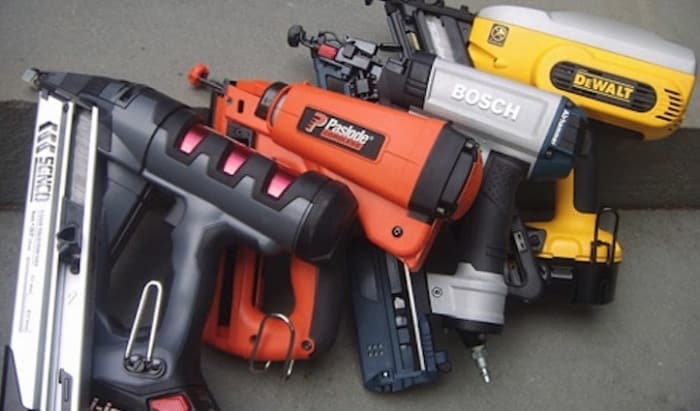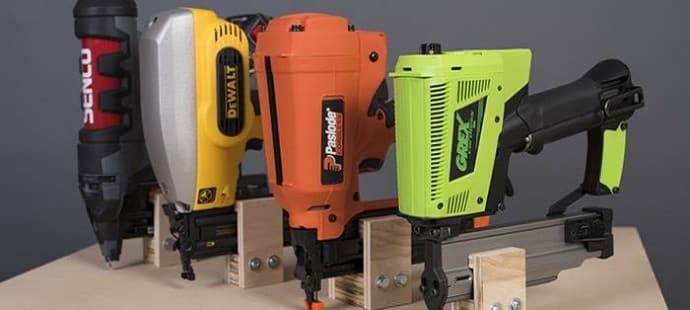A nailer, or a nail gun, typically serves one certain purpose. It is to drive a nail into a wood piece or other materials.
This device will make the job much easier than using a hammer to press a nail. It comes with two types of nailers: finish nailer vs. framing nailer.
Finish nail tools and framing nail tools show the same general feature. Both devices fasten parts together.
Yet, you should not see these nailers interchangeably. Specifically, you should take the finish nail of small and light tasks, while you should take the finishing nail to do very hard tasks.
To get a deeper investigation of two types of nailers, let’s read on!
An Overview Of Finish Nailer Vs. Framing Nailer
Before going into detail, you should gain an overview of finish nailer vs framing nailer.
Which one is more suitable? What are the advantages and disadvantages of the framing nailers and the finishing nailers? What can you do with each type?
The finishing nailer
We think that you can get the specific function of finishing nailers from the name. Finish nailers are a powerful tool to shoot the nail to complete the finishing project like wood paneling, wall trimming, and silicone moldings.
This kind of instrument is not for carrying out heavy duties.
As a result, the finishing nail gun uses smaller-size nails. It generally includes those nails which are 15 and 16 gauge. Based on the work, the common nail for the finishing nailer varies from one to two and a half inches.
Best For:
- Decorative trimmings
- Baseboards
- Wall paneling
- Crown and cove moldings
- Small-space furniture
- Compact DIY tasks
Pros
- Best for detailed jobs
- Not distracting from the graceful finishing projects
- Making a perfect match with all small nails
Cons
- Not strong enough for heavy-duty work
The framing nailer
Framing nail guns are heavy-duty equipment aimed at handling tough work. Let’s think about big nails and thick and heavy materials to complete the job.
For instance, professionals always use the framing nailer for home construction work. If you are constructing a whole dwelling or expanding a room for a house, the framing nail gun will be a good fit.
Also, other construction tasks, such as erecting a deck, need the framing nailer.
Read More:How Many Screws Per Deck Board?
Generally, a framing nailer often uses those nails which vary from one and a quarter inches to three and a half inches. These nails contain great suffering to fasten thick materials like the fence without being cracked.
Best For:
- House construction
- Fastening the fence
- Roof sheathing installation
- Thick carpentry projects
- Plastering jobs
Read More:How To Use A Framing Nailer?
Pros
- Very strong
- Robust enough to join together large parts of lumber
- Coming with three nailhead choices
Cons
- Too powerful for detailed and lightweight work
Finish Nailer Vs. Framing Nailer: Differences
After having a quick review of the two nail guns, it’s time to get an in-depth comparison and contrast of this finish nailer and this framing nailer.
Before reading, let’s look at the table below to have a view of the two nail guns.
| Category | Finish nailer | Framing nailer |
|---|---|---|
| Strength | Less powerful | More powerful |
| Preciseness | High preciseness | Low preciseness |
| Length of nails | 1-2,5 inches | 1,25-3,5 inches |
| Type of nails | Only one type | Three types of nails: round head, clipped head, and offset head |
| Price | equal | equal |
Strength
The rate of strength is the first difference between the finish nailer as well as the framing nailer. Different strengths will allow the framing nailer to be fitted for heavy tasks and the finish nailer to be matched for delicate tasks.
Because the framing nailer needs to drive the nail into thick pieces, it will require more power than the finishing nailer. This strength is essential as it can join large and heavy pieces of material.
On the other hand, the finishing nail gun contains less strength. This feature is suitable for small and detailed work. When the power level is low, it means that you will pay more attention to detail and care.
Preciseness
The framing nailer and finishing nailer are also different in terms of preciseness. The framing nailer is less accurate than the finishing nailer.
It is owing to the objective of the nail gun: the framing nailer simply brings together big and heavy pieces. Accuracy is not the priority in every task.
When you use the finishing nailer, however, accuracy will be a big issue. As a result, the finishing nail gun is much more precise than its framing nail counterpart. This feature lets the nailer complete effortless and detailed jobs like crown moldings.
Length of nails
As we mentioned before, typical nails are a good fit for every type of nail gun.
Initially, the nail ranging from one and a quarter inches to three and a half inches are best for the framing nailer. The reason is that heavy-duty work will require large nails to handle thick and weighty materials.
In contrast, the typical nail to fit the finishing nail gun varies from one to two and a half inches. You do not need long and large nails to put in the finish nailer owing to small and lightweight pieces.
Then, be careful when you want to buy some nails for your nail gun. Check the number carefully, or you will throw them into the trash basket.
Type of nails
Because the finishing nailer uses short nails for small tasks, this type of tool just uses a single nail type. The reason is that the needed nail is typically so small that the nail size does not have an influence.
In contrast, this framing nailer consists of three types of nails regarding the shape of the nailhead:
Round Head: The round-shaped head is a standard nail which is the most popular. You can buy this type of nail at any convenience store you see. The biggest advantage of round-head nails is holding the most power in comparison with others.
Clipped Head: A clipped head comes with a trimmed part of the round-shaped head. This portion is cut from the head, causing it to look like a semi-circle. So people also call it the D shape. The clipped nail can boost productivity as it takes less time to change nails.
Offset Head: An offset head is also a complete circle, but the nail body does not stand in the center of the nailhead. Instead, the head is offset to either side of the nail body.
Price
Simply put, the framing nailer as well as finishing nailer come at the same price.
The typical model you buy will decide the price, but there will not be a large difference in cost between the framing nailer and finishing nailer.
One of the main reasons is that both types of nail guns are similarly important. They are just important for specific purposes.
Who Should Use Each Type Of Nailer
As each type of nailer has a different function, it is very easy for users to select depending on the type of work.
The best thing is that you would have both of these tools. So you could take each nail gun in a specific situation. Of course, it would not be for all people as some of you may have a limited budget.
The recommendation is that beginning DIYers should choose the finishing nailer.
The finishing nail gun’s accuracy is more helpful for the kind of home task that most DIYers will do. Almost all at-home tasks are small and light. They do not require many techniques to complete the job.
The experienced users should use the second one, which is the framing nailer. These professionals will want this framing nail gun to do specialized work, such as building the house or the deck.
They have enough skills and experience to control framing nail guns to drive large nails through large and thick pieces of wood or silicone.
Wrap Up
Both types of nail guns have a sharing function, which is to drive nails through materials. But each of them will determine the level of power for every task.
The finish nailer requires less strength but more accuracy to complete small DIY work. It generally employs 1-2,5 inch nails to fasten pieces.
The framing nailer needs more power but less precision to build up a room, a house, or a deck which is a heavy-duty job. It will then use 1,25-3,5 inch nails to join materials together.
Depending on the type of work and the level of professionalism, you should choose the most suitable nailer to give the best result.
Read more: Brad Nailer Vs Framing Nailer?






